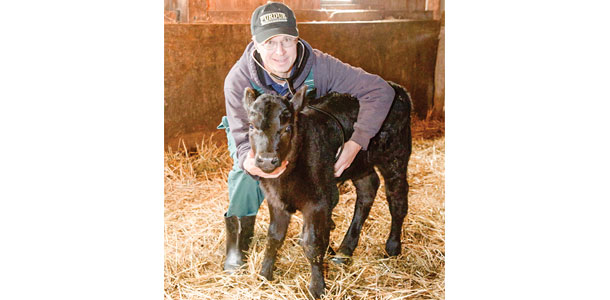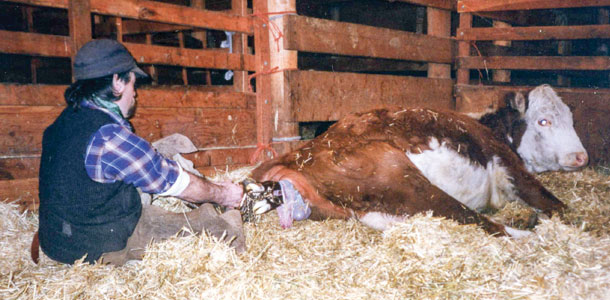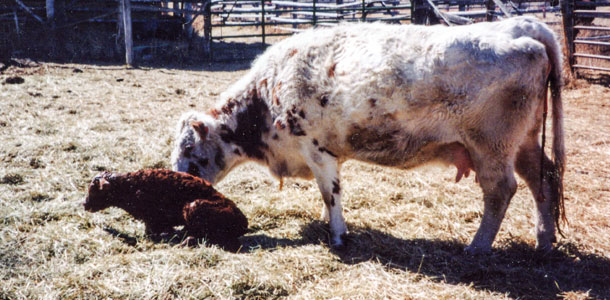
Mark Hilton of Purdue University recommends consulting a veterinarian about a month before calving to ask what they might need. “It’s sad when people have unnecessary medications in their refrigerator and they go bad. That’s wasted money,” he says.

David R. Smith, epidemiologist, Mississippi State University, says producers should use fewer antibiotics than they did traditionally. Our knowledge about antibiotics has improved, and perspectives have changed.
Cow problems
“Twenty years ago we relied on antibiotics to treat uterine infections, but today we don’t give a cow antibiotics unless she is clinically ill – with a fever and enough clinical signs that suggest there is a need,” Smith says.
We recognize that some infections don’t need treatment. The body’s immune system usually takes care of them – sometimes better than we can with medical intervention.
“Most cows with a uterine discharge are normal, and most uterine infections clear up on their own without antibiotics. Putting antibiotics into the uterus usually does more harm than good,” says Smith.
“If a producer is having problems with uterus infections (more than a sporadic case), have a veterinarian help figure out why. It shouldn’t be happening, so if you are needing to use antibiotics for a seriously sick cow, we need to find the reason and solve it,” he says.

“To prevent infections, choose a clean, dry, comfortable place for calving, and if you have to assist with a birth, take the time to be clean, wash your arms with soap and water, wash the cow with soap and water, and use lots of lubricant. We can do a lot to prevent infections just by sanitation,” Smith says.
“One thing I tell producers to always have on hand in the fridge is oxytocin,” says Hilton. “If you pull a calf, give the cow 2 ml of oxytocin IM. This will help her clean, get rid of the placenta and shrink the uterus faster.
This will reduce the chances of her prolapsing or retaining the placenta,” he says. Though oxytocin is not an antibiotic, it may reduce the risk for problems in which you might need antibiotics.
Even a retained placenta is usually not a worry. The cow sheds it eventually and doesn’t need antibiotics unless it’s the odd case where she gets a more serious infection that goes systemic – and she goes off feed and has a fever.
With a C-section, the decision whether or not to use antibiotics would depend on what the veterinarian suggests. He or she knows whether there was contamination. Did the cow lie down halfway through the procedure?
Did you have to do it outdoors and the wind was blowing straw and dust into the incision? “If everything goes perfectly, there is no need for antibiotics,” says Hilton.

But sometimes not everything is perfect. James England, University of Idaho, Caine Center, says the most common time he uses antibiotics during calving season is following C-section surgery. “Sometimes you’ll need to treat a cow for mastitis, but this is uncommon in beef cows,” he says.
You need a proper diagnosis with mastitis to know which pathogen you are dealing with. Hilton points out that if a cow has E. coli mastitis and you give her penicillin three days in a row, you are not helping her – and if she dies you’ve lost a $2,000 animal the vet could have diagnosed and treated for $100.
“You need a diagnosis first; the treatment should come second,” he says. Infection in the udder can be caused by a variety of pathogens, some more deadly than others; you want to make sure you use the proper antibiotic.
Calves
We also need to evaluate antibiotic use in calves. “Most of the pathogens that cause diarrhea in young calves are viruses or protozoa and don’t respond to antibiotics,” says Smith. The main times you’d use them is when calves become septic or develop a secondary bacterial infection.
“When we use antibiotics on scouring calves, we often make it worse. Normal flora in the gut is already disrupted by whatever is causing diarrhea, and then we disrupt it more by wiping out more of the good bacteria with antibiotics,” he explains.
This may result in taking longer to recover or the calf ending up with a fungal infection, which is worse than the original infection.
“When we do necropsies on calves that died from scours, we often find fungal infections that we probably made worse, or we set up the conditions for those fungal infections because we used antibiotics. The fluid therapy is more important, for most cases of scours, than antibiotics,” Smith says.
“There are some exceptions, such as the septic calf. But if you are having very many calves with septicemia, you need to figure out why. So this is another reason to have a veterinarian involved,” says Smith. And you’d want your veterinarian to prescribe the most effective drug for each situation.
Hilton says that if you follow best management practices like the Sandhills calving system to keep the calving environment clean, you greatly minimize the potential for calf disease. “If you routinely have calves that get diarrhea or pneumonia, you need to find out why. This is not normal.”

Disease is often the result of errors that happen during that calf’s life. “Usually two or three little things add up, and now we have a sick calf. My goal is to find those two or three things and prevent them next year,” Hilton says.
Preventing scours can be more challenging in some operations, especially if a rancher is locked into calving season that puts newborns in bad weather and bad environmental conditions.
This happens when seedstock producers must calve in January or February to have yearling bulls old enough to sell, or when Western ranchers must depend on public land grazing and need to have the cows calved out (and possibly bred again to their own bulls) before they go to summer pasture.
If a case of scours occurs, get help from the veterinarian to know whether to treat it with antibiotics. “When you call your vet, you need to know exactly how old that calf is. If it’s under 5 days old, it probably has E. coli and you can use a systemic antibiotic.
The veterinarian can recommend one he or she has used with good success in treating E. coli scours in young calves. If the calf is 10 to 18 days old, the chances it needs antibiotics are slim. If you can give the veterinarian a good history on that calf (age, how it looks, how it’s acting), the veterinarian is better able to advise on proper treatment,” says Hilton.
“Most of the time, if you get one calf with scours, there will be more getting sick because it’s highly contagious. There is value in having the veterinarian on the farm to not only suggest proper treatment for that first one; he or she might be able to help you prevent the next 20 or 30 or 100 calves from having scours. That’s the real goal,” he explains.
For young calves, England says the most important thing is supportive treatment – especially fluid and electrolytes for scouring calves. “I generally do not use antibiotics unless the calf has a fever that can’t seem to resolve,” he says.
He sees ranchers who treat with antibiotics if a young calf is breathing fast, thinking it has pneumonia. “Often, it turns out that the calf was getting ready to break with scours and is breathing hard just from the associated acidosis. What that calf really needed was fluids,” he explains. ![]()
Heather Thomas is a freelance writer based in Idaho.
PHOTOS
PHOTO1: When a calf is sick with scours or pneumonia, consult with your vet regarding whether (or which) antibiotics are needed. Photo provided by Heather Smith Thomas.
PHOTO 2: Mark Hilton, Photo courtesy of Mark Hilton.
PHOTO 3: David R. Smith, Photo courtesy of David Smith.
PHOTO 4: If everything is clean when helping a cow with a difficult birth, she won’t need antibiotics. Photo provided by Heather Smith Thomas.
PHOTO 5: James England, Photo courtesy of James England.
PHOTO 6: A clean calving area is important to help prevent problems. Photo provided by Heather Smith Thomas.






